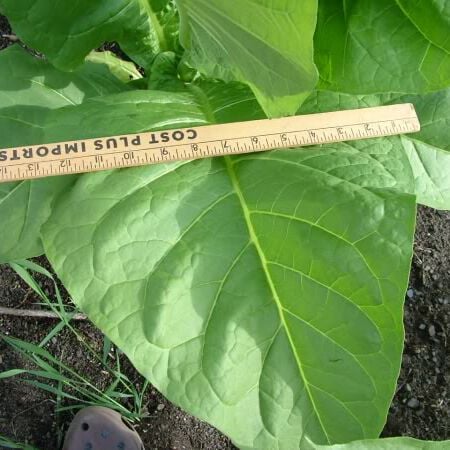Paris Wrapper, Tobacco Seed
Key Attributes
Key Attributes
Product Details
Weight
0.008Depth
0.1Height
4.5Width
3.25Plant Height
5-8'Botanical Name
Nicotiana tabacumSeed Type
SeedAdditional Characteristics
Cigar WrapperSeeds Per Gram
77,188Seeds Per Pound
35,000,000Packet
100 SeedsSow Depth
Top of SoilSeeds Per Ounce
2,187,500Breed
Open-pollinatedSun
Full SunLife Cycle
AnnualSow Method
TransplantCategories
HerbGermination
11,12,13,14,15,10Days To Maturity (# Days)
60Components
Growing Instructions
![]() Learning Download: How to Grow Tobacco
Learning Download: How to Grow Tobacco
Tobacco is usually grown in home gardens so gardeners can harvest the plant and know it has no additives. Tobacco also is grown personally for its ornamental appearance. It is a member of the nightshade family, which includes tomatoes and peppers as well. Tobacco is typically a warm-weather plant.
Before Planting: The tobacco seed is very small, so it must be started indoors. Tobacco prefers soil with a pH of 5.8 and well-drained soils.
Planting: Begin the seed in seed compost and not potting mix six weeks before the last frost. When planting, place the seed on top of the compost and do not cover it. In addition to warmer temps, it also requires light to germinate. Seedlings are ready to be transplanted once they reach 8 inches in height. Transplant them after all dangers of frost have passed.
Watering: Water 1/2 inch weekly, but be careful because over0watering can make the plants become thin and flaky.
Fertilizer: To fertilize tobacco, use the same fertilizers used for tomatoes or peppers. Fertilizer should contain no chlorine and its nitrogen should be in nitrate form. Apply the fertilizer over several separate instances, such as applying it to the soil before transplanting and continuously throughout the tobacco’s growing season to keep the leaves a solid green color. Once flowers begin to form, stop the fertilization process.
Days to Maturity: Tobacco plants can be harvested around 60 days after being transplanted.
Harvesting: Tobacco plants can be harvested by cutting down the entire plant at once or by pulling individual leaves from the plant.
Tips: To make flue-cured tobacco, the leaves are added to tobacco sticks which are then hung in a barn’s kiln, which will heat cure the tobacco but not expose it to smoke. To sun cure tobacco, the leaves are placed in the
sun and dried.
Shipping Schedule
Our Seed Promise
 "Agriculture and seeds" provide the basis upon which our lives depend. We must protect this foundation as a safe and genetically stable source for future generations. For the benefit of all farmers, gardeners and consumers who want an alternative, we pledge that we do not knowingly buy or sell genetically engineered seeds or plants.
"Agriculture and seeds" provide the basis upon which our lives depend. We must protect this foundation as a safe and genetically stable source for future generations. For the benefit of all farmers, gardeners and consumers who want an alternative, we pledge that we do not knowingly buy or sell genetically engineered seeds or plants.
The mechanical transfer of genetic material outside of natural reproductive methods and between genera, families or kingdoms, poses great biological risks as well as economic, political, and cultural threats. We feel that genetically engineered varieties have been insufficiently tested prior to public release. More research and testing is necessary to further assess the potential risks of genetically engineered seeds. Further, we wish to support agricultural progress that leads to healthier soils, to genetically diverse agricultural ecosystems, and ultimately to healthy people and communities.
To learn more about the "Safe Seed Pledge" please visit www.councilforresponsiblegenetics.org.

